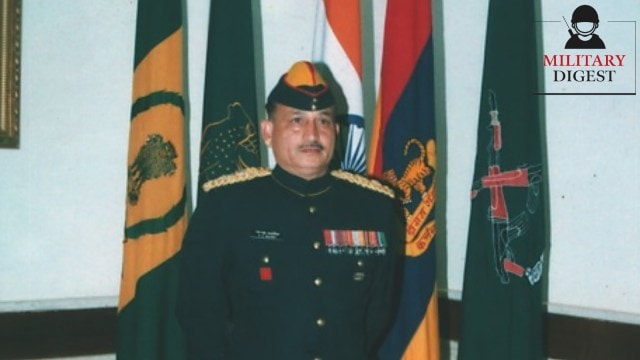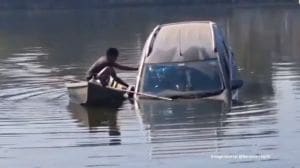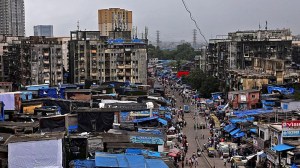Military Digest | 40 years of Operation Meghdoot: The unsung foot soldier who marched to top but has no gallantry award
Lt Col NS Salaria led the column of soldiers from the snout of the Siachen Glacier at 12,000 feet to Sia La Pass at 22,000 feet and linked up with the troops dropped by helicopters.
 Now settled in Pathankot after retiring in 2003, Lt Col Salaria remembers each detail of Op Meghdoot, launched 40 years ago. Originally commissioned in 6 Dogra, he later joined 12 Dogra, a newly raised battalion. (Express Photo)
Now settled in Pathankot after retiring in 2003, Lt Col Salaria remembers each detail of Op Meghdoot, launched 40 years ago. Originally commissioned in 6 Dogra, he later joined 12 Dogra, a newly raised battalion. (Express Photo)On the 40th anniversary of Operation Meghdoot, the occupation of the heights around the Siachen Glacier by the Indian Army in 1984, it is pertinent to recall the superhuman efforts of the band of soldiers who were the first to march on foot from the Base Camp to Sia La and raise the Indian Tricolour. However, not much is known about these brave soldiers, and the officer who led them on foot was not decorated with any medal for his accomplishment.
Lt Col NS Salaria, then a senior Major with 14 years of service, led the column of soldiers from the snout of the Siachen Glacier at 12,000 feet to Sia La Pass at 22,000 feet and linked up with the troops dropped by helicopters in the first wave of operations by the Indian Army and Indian Air Force (IAF) to occupy the Siachen Glacier.
These troops, marching on foot, had the longest march on the glacier, starting from Sasoma on March 21. After establishing staging camps at Henachi, Warshi, and Base Camp, they were launched on Siachen Glacier, finally unfurling the Tricolour on Sia La on April 29.
Now settled in Pathankot after retiring in 2003, Lt Col Salaria remembers each detail of Op Meghdoot, launched 40 years ago. Originally commissioned in 6 Dogra, he later joined 12 Dogra, a newly raised battalion.
“I was the Adjutant at the regimental centre when the then GOC 15 Corps, Lt Gen Hoon, who was from our regiment, visited the centre in September 1983 and asked for volunteers to serve in the Siachen operations. I volunteered and was posted with the Ladakh Scouts in Ladakh,” he says.
Eventually, for the actual operations, Lt Col Salaria was made the Commander of a company with seven officers, 13 JCOs, and 175 jawans. While the troops dropped by helicopters were the first ones to occupy the Bila Fond La and Sia La passes, this company, led by Salaria, was to link up with these forces and provide a crucial backup against potential Pakistani attacks.
“The first problem we faced was that we did not have snow equipment. On April 12, the equipment purchased by the Army from Western suppliers arrived at the base camp by helicopter. Priority was given to heliborne troops for this equipment. Therefore when we marched the next day we went with normal winter clothing that is issued by the Army,” says Lt Col Salaria.
 Lt Col NS Salaria, then a senior Major with 14 years of service, led the column of soldiers from the snout of the Siachen Glacier at 12,000 feet to Sia La Pass at 22,000 feet. (Express Photo)
Lt Col NS Salaria, then a senior Major with 14 years of service, led the column of soldiers from the snout of the Siachen Glacier at 12,000 feet to Sia La Pass at 22,000 feet. (Express Photo)
This company, led by Salaria, also opened the route to Tershan Glacier, established camps on the way in, and linked up with heliborne forces.
“There was a Tactical HQ at Tershan Glacier. We stopped there for three days, and then the equipment arrived by helicopter which we donned for our further march up,” he says.
These foot soldiers used to walk for 10-12 km per day in deep snow. There were crevices to negotiate as they established six camps and then turned left towards PoK and Sia La. At the same time, another team comprising trained personnel from High Altitude Warfare School (HAWS) turned right towards Indira Col, which they had to occupy.
“On April 28, I established Camp 6, and we put ourselves down for some well-deserved rest as we were all dead tired carrying 40 kgs of load on our backs. At that time, I had 55 boys with me, having dropped troops at each camp we established. At 7 pm, I got a message on the radio set from the Sector Commander, Brig V Channa, who told me that he knew we were tired but that this was a do-or-die mission now,” he recalls.
A surprised Salaria inquired what had happened and was told that the Pakistani forces were expected to contact Sia La early morning. “Brig Channa told me that we just have one platoon on Sia La, and they cannot resist, and you have to occupy by first light. I told him my troops were exhausted but he said the task had to be done at all costs. I gathered my boys and told them the mission, but many said they were too tired to go on. Then I gave them a lecture and 35 boys got ready. We dropped all extra equipment like sleeping bags, kerosene, etc and only carried out weapons, ammunition and grenades. We marched through the night, and at 4 am, we linked up with Sia La post,” he says.
Lt Col Salaria’s troops reached just in time, as at 8 am, three Pakistan Army helicopters arrived to carry out reconnaissance for the attack. “They saw us deployed there and went back. Had we not gone and occupied Sia La in aid of the platoon there, they would have been overwhelmed,” he says.
Sadly, Lt Col Salaria was not awarded a gallantry award for leading this stupendous effort. He is the only undecorated officer whose name is displayed in the hall of fame at Officers Training Academy (OTA), Chennai, where he graduated in March 1970.







